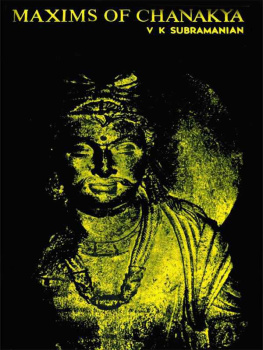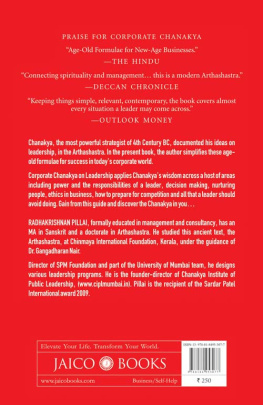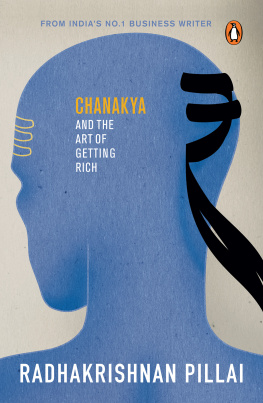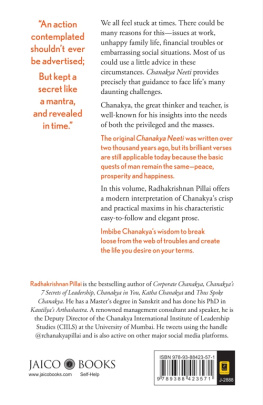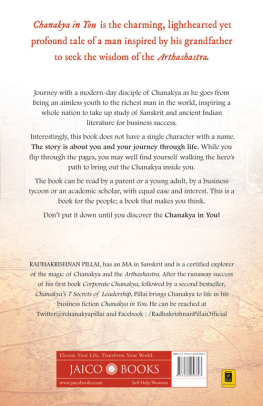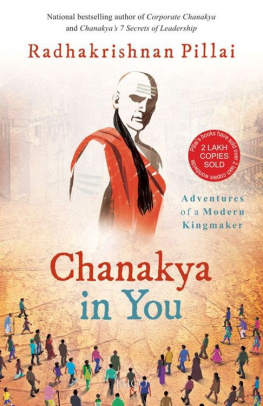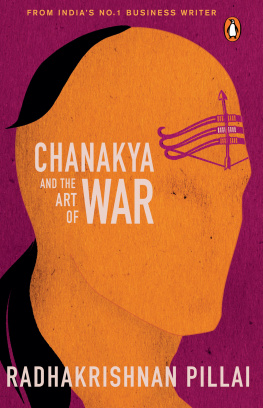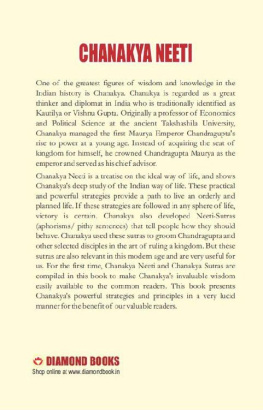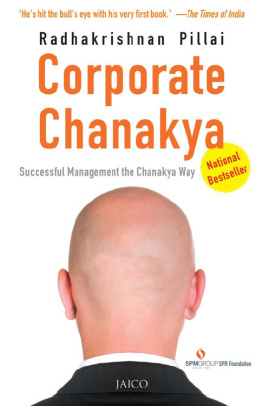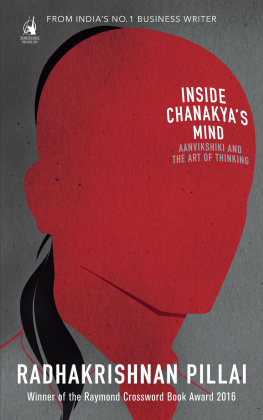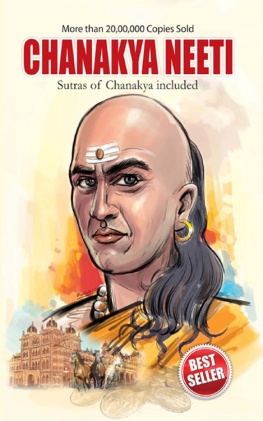V.K. Subramanian - Maxims Of Chanakya
Here you can read online V.K. Subramanian - Maxims Of Chanakya full text of the book (entire story) in english for free. Download pdf and epub, get meaning, cover and reviews about this ebook. publisher: GAPPAA.ORG, genre: Science. Description of the work, (preface) as well as reviews are available. Best literature library LitArk.com created for fans of good reading and offers a wide selection of genres:
Romance novel
Science fiction
Adventure
Detective
Science
History
Home and family
Prose
Art
Politics
Computer
Non-fiction
Religion
Business
Children
Humor
Choose a favorite category and find really read worthwhile books. Enjoy immersion in the world of imagination, feel the emotions of the characters or learn something new for yourself, make an fascinating discovery.
- Book:Maxims Of Chanakya
- Author:
- Publisher:GAPPAA.ORG
- Genre:
- Rating:4 / 5
- Favourites:Add to favourites
- Your mark:
- 80
- 1
- 2
- 3
- 4
- 5
Maxims Of Chanakya: summary, description and annotation
We offer to read an annotation, description, summary or preface (depends on what the author of the book "Maxims Of Chanakya" wrote himself). If you haven't found the necessary information about the book — write in the comments, we will try to find it.
Maxims Of Chanakya — read online for free the complete book (whole text) full work
Below is the text of the book, divided by pages. System saving the place of the last page read, allows you to conveniently read the book "Maxims Of Chanakya" online for free, without having to search again every time where you left off. Put a bookmark, and you can go to the page where you finished reading at any time.
Font size:
Interval:
Bookmark:
Maxims Of Chanakya
by
GAPPAA.ORG
V. K. Subramanian
First Published : 1980
Second Edition : 1990
Reprint Edition : 1996
Reprint Edition : 2000
Publishers
Shakti Malik
Abhinav Publications
E-37, Hauz Khas
New Delhi-110016
GAPP AA.ORG
''Maxims of Chanakya'' is the crystallised wisdom of Chanakya, also known as Kautilya, the Indian Philosopher-Statesman, who helped Chandragupta Maurya establish the first unified state in Indian History in Fourth century B.C.
Often called the Indian Machiavelli, Chanakya is Known for his political acumen and statecraft which enabled him to win bloodless victories over his enemies, overthrow a tyrannical regime and prevent the balkanisation of India at a time when it was ravaged by foreign invasions.
The maxims of Chanakya, over one thousand in number, included in this book, culled from the three major works attributed to him: Arthasastra, Chanakyasutras and Chanakyarajanitisastra (sometimes known as Chanakyanitidarpana), cover a wide range of subjects.
No branch of life or learning has been left untouched by the great political genius, He has something pithy to say on politics, administration, economics, ethics, education, health, sex and self-improvement.
In terseness of expression, no language, with the possible exception of Latin, can excel Sanskrit and the great master has used this wonderful language to such perfection that one is awestruck by the volume of message often conveyed in a couple of words.
The English translation of Chanakya's original Sanskrit maxims captures their brevity and wisdom, for the benefit of a larger audience, not conversant with the Sanskrit language.
The introduction: ''Chanakya: His Life, Times and Work'' adds to the value of this publication.
It is hoped that '' Maxims of Chanakya " will prove an invaluable guide to the Legislator, the Administrator, the Planner and the Educationist-all those who shape a country's policy or an individual's future.
GAP PAA.ORG
Born in 1930 in Kerala (India), Vadakaymadom Krishnaiyer Subramanian, the author of several books, is a keen student of Indian affairs, ancient and modern. An eminent Sanskrit scholar, he has translated several ancient Indian Sanskrit texts into English. His publications in this regard include Rudraprasna, Sivanandalahari, Saundaryalahari and Maxima of Chanakya. He has just completed a mammoth work, Siva-Sakti. Subramanian has also written several works of fiction, which include Lali and Other Short Stories, Love- Twigs and A Bond to Sorrow. His book on astrology and planets, Planets, Palms and Predictions, is a highly popular publication.
Subramanian is also a reputed artist and art historian. He has held 18 one-man exhibitions of his paintings, which have won wide acclaim from art critics and the press throughout the country. His book, The Great Ones in Art, is being published by the Bharatiya Vidya Bhavan, Bombay.
Subramanian's perceptive thorough-ness on Indian public finance would be evident to any reader of The Indian Financial System.
My Sons Anand, Mukund and Arvind
and
My Critics, Confidantes and Counsellors
GAPPAA.ORG
GAPPAA.ORG
My thanks are due to the University of Mysore and the Adyar Library and Research Centre, whose critically edited Sanskrit texts have been used in the writing of this book.
I am also grateful to Dr. V. Raghavan, Head of Department of Sanskrit, University of Madras, who helped me with a number of books, without which it would have been impossible for me to complete this book.
I am also indebted to Sri S. Ramakrishnan, Editor, Bhavan's Journal for kindly permitting me to use in book form some of the maxims serialised in the Bhavan's Journal between July 1972 and December 1973.
V.K. SUBRAMANIAN
GAPPAA.ORG
(Chanakya: His Life, Times and Work)
Chanakya, also known as Kautilya and Vishnugupta, was the famous Indian Machiavelli who was responsible for the overthrow of the last ruler of the Nanda Dynasty and the enthronement of Chandragupta Maurya. Brahmin by caste, he roughly lived during the period 350-275 B.C.
There is an interesting story about Chanakya's first encounter with Chandragupta, which ultimately ended in their collaboration and capture of power.
One day when Chandragupta who had been dismissed from Nanda's army was walking through the forest he saw a Brahmin pouring sugar syrup on the roots of Kusa grass. Rendered curious, Chandragupta asked Chanakya the rationale of his action. Chanakya replied: This Kusa grass hurt my leg. I hence intend to destroy it. By pouring sugar syrup, 1 am rendering the root of the grass sweet. As a result, thousands of ants will be attracted to it. These ants will nibble at and destroy the root and the grass will die.
Even as he spoke, the ants staitcd collecting and soon there was an army of ants around the root of the Kusa grass which had hurt Chanakya. Chandragupta bowed his head before the sagacity and foresight of Chanakya and pleaded for his help and advice in becoming a Ruler. Chanakya, who already bore a grudge against Nanda, readily agreed.
Chanakya helped Chandragupta in raising a large army and defeating Nanda. After making him the Emperor of India, Chanakya functioned as his Counsellor and advised him in all matters of the State.
With the able advice of Chanakya, Chandragupta Maurya ruled for twenty-four years.
Biographical details available about Chanakya are scanty. We have mainly to rely on tradition, and the Buddhist and Jain texts of later periods.
Chanakya's place of birth is a matter of controversy. The Mahavamsa Tika, a Ceylonese Buddhist work mentions Taxila as his birth place, while Hemachandra, the Jain writer in his Abhidhanachintamani says that Chanakya, son of Chanaka, was a Dramila, that is, an inhabitant of South India.
There is another version that the name Chanakya is derived from the name of his native land (some place called Chanaka in the Punjab) as per a statement in the Jayamangala commentary on the Nitisara,
A place called Gollavishaya has also been mentioned as the birth place of Chanakya in the Parisishtaparvan.
Kerala has also staked a claim as the homeland of Chanakya on the basis that his tuft was that of a Nambudiri Brahmin.
Since Alexander's campaigns were predominantly in the Punjab and Plutarch has gone on record that Alexander had met Chandragupta as a youth during his campaigns, it would be safer to accept the version that Takshasila (Taxila) in the Punjab was the native city of Chanakya, where he and Chandragupta spent several years together.
Though the story about the encounter between Chanakya and Chandragupta mentioned at the beginning of this introduction is the popular one, according to Buddhist texts and traditions, accepted by historians, the version is that Chanakya found Chandragupta in a village as the adopted son of a cowherd from whom he bought the boy by paying on the spot 1,000 Karsapanas, seeing in him the sure promise of future greatness. Chanakya is supposed to have taken the young Chandragupta with him to his native city of Takshasila (Taxila), then the most renowned seat of learning in India and had him educated there for a period of seven or eight years in the Humanities and the Practical Arts and Crafts of the time, including the Military Arts.
Font size:
Interval:
Bookmark:
Similar books «Maxims Of Chanakya»
Look at similar books to Maxims Of Chanakya. We have selected literature similar in name and meaning in the hope of providing readers with more options to find new, interesting, not yet read works.
Discussion, reviews of the book Maxims Of Chanakya and just readers' own opinions. Leave your comments, write what you think about the work, its meaning or the main characters. Specify what exactly you liked and what you didn't like, and why you think so.

